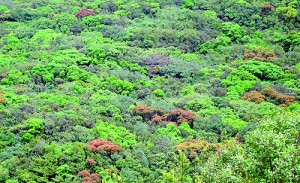News
Garden lizard gains an elite relative from Knuckles
The common green garden lizard that belongs to the Agamid lizard family this week gained a new relative that brings to 19 the number of spcies in this group, 16 of them endemic to Sri Lanka.

Knuckles World Heritage Forest is home to more unique creatures
The new addition is been a result of strenuous scientific analysis under difficult conditions by young researchers Thasun Amarasinghe and Sameera Suranjan Karunaratne.
This lizard lives in the forests in the Knuckles Range. It had been misidentified as the Crestless Lizard – Calotes liocephalus. Studying the lizard in the Central Highlands and the Knuckles Range, researchers Amarasinghe and Karunaratne spotted some differences in the Crestless Lizards found in Knuckles Range from the same species found in the Peak Wilderness in the Central Highlands. After further study they concluded that the Knuckles lizards were a different species.
Researchers only had nine male specimens from the Knuckles and five males from the central highland to conduct this study but they said the differences were significant enough to classify this species. The specimens in the Wildlife Heritage Trust (WHT) and other museums too had been studied.
Males of the new species are different from males of C. liocephalus because of the absence of a gular pouch and by having mid-gular scales smaller in size than those of its counterpart. The scales in different parts of the body too had clear distinctions, helping the researchers to separately identifying the two species.
But this left researchers with another challenge. C. liocephalus was classified by a researcher named Günther in 1872 using a single male specimen. He did not mention the precise location of the type specimen collected. Thus Amarasinghe and Karunaratne had to compare the holotype with museum specimens and live specimens (not collected) from the Knuckles massif and Central Highlands. The type specimen has been secured in the Natural History Museum in London and Mr Amarasingha also visited the museum to carry out further research.
“After identifying the specimens, we saw that the holotype resembled the Central Highlands populations. Hence we describe the population distributed in the Knuckles massif as a distinct species” said Mr Karunaratne.
He and his colleague named the new lizard Pethiyagoda’s Crestless Lizard – Calotes pethiyagodai – to honour Rohan Pethiyagoda for his effort to make Sri Lanka a biodiversity hotspot. In Sinhala the lizard’s is name is Pethiyagodagë Nosilu Katussa.
The scientific paper describing this finding was published in the prestigious journal ZooTaxa. Researchers from Germany, Japan, Austria and England where specimens of these species exist helped the local researchers to make the comparison.
“It is not easy to get measurements of this specimen as it involves a physical count of the scales. It takes about a day to study a single specimen so scientists who helped us had to spend days analysing the specimens in their possession. So they too have been included as authors of this paper: they are Jakob Hallerann, Junichi Fujinuma, Heiz Grillitsch and Patrick D. Campbell.
Knuckles is already famous for its Horned Lizard and this new find will add more value to the area declared a UNESCO Natural World Heritage.


